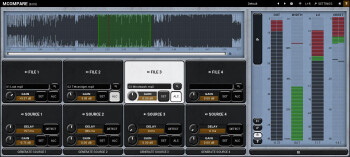Today I'll suggest a non-exhaustive list of tools that can make your life easier during the critical listening sessions of your mixes in your home studio.
Tools of the trade
Before we begin, do note that to make the best of the following tools it’s better not to insert them in the Master bus, but rather on the listening bus so that the processing is not mistakenly applied to the mix during the final export. If your DAW doesn’t feature such a bus, you can always use them on the Master bus, but you we’ll have to remember to deactivate them before exporting your mix.
Okay, let’s begin with a couple of plug-ins that will allow you to focus on the mono, stereo and mid and side aspects of your mix:
None of these tools is perfect in itself, but since they are all free, nothing stops you from combining them to get the best results.
When it comes to listening by frequency ranges, you can get away with using an EQ with high-pass and low-pass filters with a steep slope (48 dB/octave) to focus your listening on certain frequency zones. Personally, I prefer to use multi-band EQs like Blue Cat Audio’s MB-7 Mixer 2, FabFilter’s Pro-MB or even the TDR Nova — which is available as a freeware — because they provide a “solo” listening option for the different bands. And for something even more direct, the freeware SlewOnly and SubsOnly by Airwindows are wonderful because you only need to activate/deactivate them to focus on the high and low end of the spectrum, respectively. Do note however that they don’t have any settings and you can’t adjust the cut-off frequency.
To finish, here are a couple of options that will make A/B comparisons easier. You can certainly use an external playback device and a hardware monitor controller to toggle easily and quickly between your mix and the reference song. However, you shouldn’t discard the option of importing the reference song into your DAW so you can do a more targeted comparison using the tools mentioned above. In this case, you could for instance, listen only to the low end of your mix and that of a commercial song to see how they compare. What’s more there are some specially designed plug-ins to make A/B comparison easier, like Sample Magic’s Magic AB or MeldaProduction’s MCompare.
And before I finish I would also like to draw your attention to a small jewel I discovered recently: the HOFA Plugins 4U+ BlindTest, whose goal is to simplify the comparison of audio processing. That said, nothing stops you from using it to compare your mix with a reference song. It includes an automatic gain compensation function, so you won’t be biased by the famous “louder is better” effect. And to top it off, HOFA Plugins offers a free lightweight version of the 4U+ BlindTest which is more than enough for the use I just described. Isn’t life beautiful?

